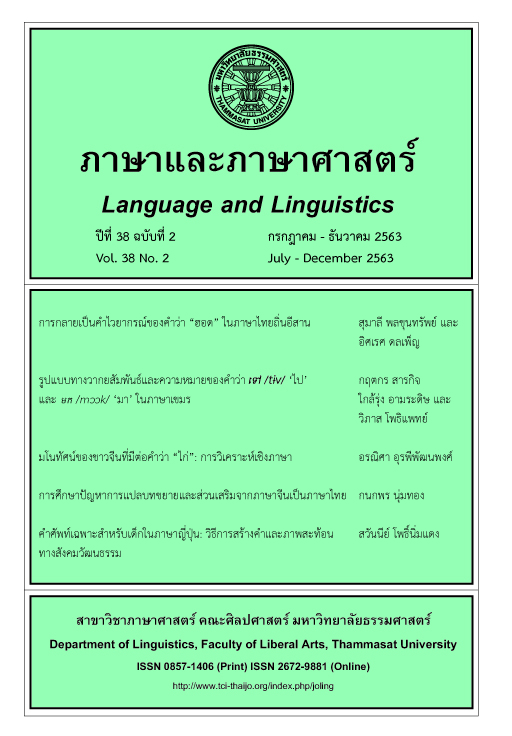The Chinese concept of “Ji” through language analysis
Main Article Content
Abstract
This article studies the Chinese concepts and its conceptual changes of 鸡 (Ji chicken) through Mandarin Chinese. In Chinese culture, people believe that “chicken” is an
auspicious animal and plays the important role in traditional customs and rituals. However, 鸡 (Ji chicken) in Chinese everyday life and language usage involve negative meanings. The objectives of this article are to analyse the meanings of animal metaphors and expressive meanings of “Ji” (鸡, chicken) in Mandarin Chinese lexicons and idioms. The results show that Chinese concepts of “Ji” mostly convey negative meanings, despite that conceptual metaphors of 鸡 (Ji chicken) are deviated from the traditional beliefs and certain special characteristics of the Mandarin Chinese.
Article Details
บทความทุกบทความเป็นลิขสิทธิ์ของภาษาและภาษาศาสตร์
References
ชัชวดี ศรลัมพ์. (2548). อุปลักษณ์ตามแนวคิดของทฤษฎีภาษาศาสตร์ปริชาน. วารสารศิลปศาสตร์, 5(1), 1-16.
ชัชวดี ศรลัมพ์. (2561). อรรถศาสตร์. กรุงเทพฯ: จรัลสนิทวงศ์การพิมพ์.
ดียู ศรีนราวัฒน์ และชลธิชา บำรุงรักษ์ (บ.ก.). (2558). ภาษาและภาษาศาสตร์. กรุงเทพฯ: สำนักพิมพ์มหาวิทยาลัยธรรมศาสตร์.
ถาวร สิกขโกศล. (2560). ภาษา อักษร และคำคมสุภาษิตจีน. กรุงเทพฯ: แสงดาว.
Yao Siqi. (2559). อุปลักษณ์เชิงมโนทัศน์เกี่ยวกับหงส์และไก่ในภาษาจีน. วารสารอักษรศาสตร์, 45(2), 1-58.
Yao Siqi. (2561). การศึกษาเปรียบเทียบอุปลักษณ์ “ไก่” ในภาษาจีนและภาษาไทยตามมุมมองทางปริชาน. วารสารวิเทศศึกษา, 8(1), 169-195.
CASS Institute of Linguistics Dictionary 中国社会科学院语言研究所词典编辑室. (2018). 现代汉语大词典 (第7版). 北京: 商务印书馆.
Chang Jingyu 常敬宇. (2009). 汉语词汇与文化. 北京: 北京大学出版社.
Chengyudacidian bianweihui《成语大词典》编委会. (2019). 成语大词典 (第2版). 北京: 商务印书馆国际有限公司.
Jia Xiaohui & Quan Yuping贾晓慧、权玉萍. (2009). 谈动物与中国文化, 野生动物, (1).
Ma Yukun马玉堃. (2015). 中国传统动物文化. 北京: 科学出版社.
Song Yanfang & Yu Yan 宋艳芳、俞燕. (2006). “鸡”字成语隐喻浅析, 文教资料, (30).
Standardization Administration of China 中国国家标准化管理委员会. (2012). 汉语拼音正词法基本规则. Retrieved from http://www.moe.gov.cn/ewebeditor/uploadfile/2012/08/21/20120821100233165.pdf
Sun Hongde 孙洪德. (2005). 汉语俗语词典. 北京: 商务印书馆国际有限公司.
Tan Wenhui谭文辉. (2001). 动物词语文化意义的认知模型, 福建外语, (4).
Xiao Yaoyao肖遥遥. (2008). 动物隐喻的认知基础及语义演变,郑州航空工业管理学院学报 (社会科学版), (6).
Yu Haiguang于海广. (2009). 多彩鸡文化.济南: 齐鲁书社.
Zhou Qian 周谦. (2014). 学生歇后语谚语惯用语大词典.北京: 外语教学与研究出版社.


